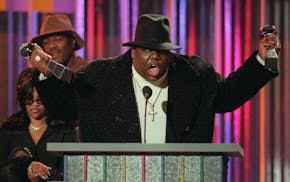Minnesota once again became a chilly kingdom in 2013. Snow fell heavily into May, and the year ended with a cold and snowy December. Half the months were colder than normal (although "normal" is warmer than it used to be), and in April, the Twin Cities saw a record daily low temperature for the first time in nine years. Summer and fall brought warmth but not bliss, exactly, when windstorms took out thousands of trees across the state and a dry spell led to a late, drab fall. There was some good news: Only 15 tornadoes were documented in the state in 2013, the fewest in more than 20 years. And, according to the outlook, it'll be warm enough in 2014 for the Vikings to play outdoors.
January
New Year's Day brought the first of only nine subzero lows for the winter to the Twin Cities, 5 below. The high temperature of 2 below on Jan. 21 ended a 1,466-day streak with highs above zero, a record by 324 days, and perhaps an indication that things were about to change. The 0.49 inches of precipitation in the Twin Cities on Jan. 27 (worth only 3 inches of snow) was a record for the date.
February
The wait for snow in much of the state ended. Rothsay, in western Minnesota, got 21 inches Feb. 10-11. In the Twin Cities, 0.62 inches of precipitation Feb. 10 broke a 115-year-old local record for the date (with only 2 inches of snow), the second such daily record in two weeks. February became the first of four consecutive months with a below-normal average temperature in the Twin Cities.
March
Spring? Hah. A two-stage snowstorm dropped 11 inches March 4-5 at Millerville, near Alexandria, and 9 inches on much of the southern half of the state. A blizzard March 17-18 left 11 inches behind at Isabella. Crookston and Elbow Lake recorded morning lows of 8 below March 20, as spring allegedly began, while the Twin Cities saw 5 above, with 8 inches of snow still on the ground. It was the coldest March in the Twin Cities since 2002, just a year after the warmest March on record.
April
The Twins opened at Target Field April 1 under sunny skies and a temperature of 35 degrees. Pitcher Vance Worley celebrated the return of the summer game by going sleeveless, but winter wasn't gone for good. Ice and snow from a slow, four-day conglomeration of storms April 9-12 destroyed 20 percent of the public trees in Worthington. The snow racked up daily records around the state, the extreme being 25 inches at Isabella on April 19. The Twin Cities saw rain or snow for 10 consecutive days, April 5-14. Duluth had its snowiest April ever, with 50.8 inches. The 21-degree low on April 20 in the Twin Cities was the first record low temperature in nearly nine years. April in the Twin Cities was the 13th-coldest, fifth-wettest and third-snowiest. An unprecedented late thaw helped spare Fargo-Moorhead from a predicted major Red River flood, because the deep snow melted into soil instead of rushing across frozen land.
May
No, winter still wasn't over. Students across the region got a snow day mere weeks before summer vacation, compliments of a storm that dumped 15.4 inches at Dodge Center, a May 2 state record. Ultimately, March through May was the wettest meteorological spring on record for southeast Minnesota, as well as eighth-wettest and the third-coldest statewide. It was chilly, as well. Lake Minnetonka was finally declared ice-free May 2, the first May ice-out since 1965. Many lakes remained frozen or had some ice cover for the May 11 fishing opener. In the Twin Cities, rain or snow fell on 23 of 31 days. Heat made a brief but memorable introduction. May 14 brought a state record 103 to Winnebago and Sherburn and a local record 98 to the Twin Cities, where, despite an uncomfortable heat wave in late August, May 14 was the warmest day of the year.
June
Spring Grove and Wells in southern Minnesota reported more than 12 inches of rain for their wettest June ever. Two storms on the first day of summer damaged or destroyed 3,000 trees on public land in Minneapolis and knocked out power to more than 600,000 Xcel Energy customers. It was the most extensive outage on record for Xcel; some Twin Cities residents went without power for more than five days.
July
Predawn thunderstorms July 13 dropped 6 to 8 inches of rain across some parts of south-central Minnesota, causing flooding. The Twin Cities' 2.79 inches was a record for the date. An EF2 tornado in Mahnomen and Clearwater counties at about 2 a.m. July 22 was the strongest to hit the state during the year. The 64-degree high in the Twin Cities July 27 was the chilliest on record for the date; the low of 39 in Pipestone was the coldest temperature for the date in 102 years.
August
Hail up to 3 inches in diameter, heavy rain and high winds pounded communities statewide Aug. 6, breaking car windows, ripping down tree limbs and forcing National Night Out parties inside. Brimson, just north of Two Harbors, had a frosty low of 30 on Aug. 14. Minneapolis schools opened amid a heat wave at the end of the month; officials excused absences for students whose schools weren't air-conditioned. Early attendance at the State Fair (third-warmest on record) flagged, but a cool-down brought record crowds the final two days. Meteorological summer (June-August) ended 1.6 degrees above normal in the Twin Cities; the slightly below normal (85 percent) rainfall balanced the extremely wet spring.
September
Drought talk returned as the Twin Cities received just under half of the normal rainfall for the second month in a row. Heavy rains fell elsewhere. Pelican Rapids received 2.23 inches Sept. 15-16. On Sept. 19, a storm with high winds and large hail ripped southwest-to-northeast across the state.
October
The Twin Cities had an Oct. 2 record rainfall of just under an inch — paltry compared with the 2.76 inches at Pine Island and 1.4 at the University of Minnesota St. Paul campus Oct. 3, both local records for that date as well. Those amounts were eclipsed by the 5.85 inches of rain at Preston overnight Oct. 5, a statewide record for the date, that came in a storm that caused flooding across southeastern Minnesota and closed Hwy. 61 in Winona County with a mudslide. To the north, much of central Minnesota had nearly double the normal rainfall for the month.
Towns in east and northeast Minnesota got 5 inches of snow the week of Oct. 18-24. But Minneapolis-St. Paul International Airport, where official Twin Cities conditions are logged, didn't get its first frost of the season until Oct. 27, three weeks later than average.
November
Leaves lingered on trees in the Twin Cities through the first week of the month; many fell green because of the late spring and dry conditions in late 2012 and mid-2013.
December
Winter stomped in Dec. 2-4 with 35.3 inches of snow north of Two Harbors, closing schools for two days in Duluth. In the Twin Cities, snow fell on 23 days in the month. The snow was escorted by deep, widespread cold, making it the seventh-coldest December on record for the state. Embarrass hit 43 below on Dec. 31, the statewide low for the year. The Twin Cities saw 11 subzero overnight lows in the month, but there was also a record high of 47 on Dec. 28. In International Falls, "the Icebox of the Nation," it was the second-coldest December on record.
Bill McAuliffe • 612-673-7646
NPR suspends editor who criticized his employer for what he calls an unquestioned liberal worldview

Salman Rushdie's 'Knife' is unflinching about his brutal stabbing and uncanny in its vital spirit

![Laura and John Reinhardt walked with umbrellas in the snow around Lake Nokomis in Minneapolis, Minn., on Monday, April 22, 2013. ] (RENEE JONES SCHNEI](https://arc.stimg.co/startribunemedia/OBQHYYQBH4WGM53ZWLABXHBFEU.jpg?w=600&h=600&auto=format%2Ccompress&cs=tinysrgb)